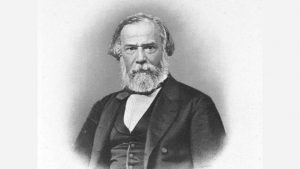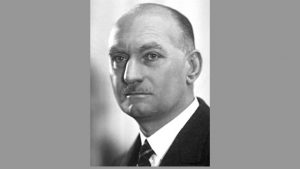 Animals
Animals  Animals
Animals  Weird Stuff
Weird Stuff 10 Weird Things People Used to Do at New Year’s
 Our World
Our World 10 Archaeological Discoveries of 2025 That Refined History
 Weird Stuff
Weird Stuff 10 Fascinating Facts You Might Not Know About Snow
 Miscellaneous
Miscellaneous Top 10 Things Crypto Was Supposed to Change & What Actually Did
 History
History 10 Huge Historical Events That Happened on Christmas Eve
 Music
Music 10 Surprising Origin Stories of Your Favorite Holiday Songs
 History
History 10 Less Than Jolly Events That Occurred on December 25
 Weird Stuff
Weird Stuff 10 Funny Ways That Researchers Overthink Christmas
 Politics
Politics 10 Political Scandals That Sent Crowds Into the Streets
 Animals
Animals 10 Species That Refused to Go Extinct
 Weird Stuff
Weird Stuff 10 Weird Things People Used to Do at New Year’s
 Our World
Our World 10 Archaeological Discoveries of 2025 That Refined History
Who's Behind Listverse?

Jamie Frater
Head Editor
Jamie founded Listverse due to an insatiable desire to share fascinating, obscure, and bizarre facts. He has been a guest speaker on numerous national radio and television stations and is a five time published author.
More About Us Weird Stuff
Weird Stuff 10 Fascinating Facts You Might Not Know About Snow
 Miscellaneous
Miscellaneous Top 10 Things Crypto Was Supposed to Change & What Actually Did
 History
History 10 Huge Historical Events That Happened on Christmas Eve
 Music
Music 10 Surprising Origin Stories of Your Favorite Holiday Songs
 History
History 10 Less Than Jolly Events That Occurred on December 25
 Weird Stuff
Weird Stuff 10 Funny Ways That Researchers Overthink Christmas
 Politics
Politics 10 Political Scandals That Sent Crowds Into the Streets
10 Scientists Who Enabled Brains to Survive Bodily Death
As Emilie Le Beau Lucchesi points out in an article for Discover, in 1536, witnesses to Anne Boleyn’s execution claimed that her severed head’s lips moved, causing them to wonder whether she was attempting to speak. Likewise, when Jean-Paul Marat’s assassin, Charlotte Corday, was guillotined in 1793 and her executioner slapped the cheeks of her decapitated head, “onlookers claimed” that her “face flushed,” as if she were displeased by “the insult.” Had Corday, like Boleyn, survived death for a few seconds?
Such musings may have inspired a series of horror movies in which scientists sought to keep the brains of dead individuals alive using such methods as transplantation in The Brain That Wouldn’t Die (1962), immersion in a chemical bath in The Brain (1962), and a mysterious reanimating reagent in Re-Animator (1985). To add a twist, several such films included telepathy as a side-effect.
The ten scientists on this list succeeded in accomplishing what, before, was only feasible by conjecture or fantasy: Each of them enabled brains to survive bodily death, even if only for a short time.
Related: 10 Seriously Strange Beliefs Humans Held Throughout History
10 Charles-Édouard Brown-Sequard

To say that Charles-Édouard Brown-Sequard (1817–1894) was an unusual person would be an understatement. However, he was also a scientist of genius whose sometimes bizarre experiments added to the understanding of physiological processes.
Accounts differ regarding the outcome of an 1857 experiment in which he delivered fibrin-free, oxygen-impregnated blood through the arteries of a decapitated dog’s head, thereby reversing rigor mortis. But Alex Boese appears convinced that this process, known as perfusion, restored life to the head, which showed apparent “voluntary movements in the eyes and face” as well as “tremors of anguish” until, a few minutes later, the head again died.[1]
9 Jean-Baptiste Vincent Laborde

Jean-Baptiste Vincent Laborde (1830–1903) showed that Brown-Sequard’s process could have the same effect on humans who’d lost their heads to the guillotine. As an article on the Centre for Cellular and Molecular Biology’s communication website SciTales declares, through bribery, Laborde secured the head of a recently guillotined criminal. He then perfused the blood vessels on the left side of the head with “oxygenated cow blood” after “suturing” those on the right side of the head with a dog’s blood vessels. The result: the criminal’s head became animated, its facial muscles tightening, its tongue seeming to “boil,” and its jaw slamming shut.
Although the question of whether such animation proved that a decapitated head retained awareness for some time after it had been severed from the body remained controversial, French physician Gabriel Beaurieux believed that consciousness did continue after decapitation for up to four seconds in both dogs and humans. As Matthew D. Turner relates, after calling out the name of a guillotined prisoner, Beaurieux himself witnessed the man’s “eyelids slowly lift up, without any spasmodic contraction,” meet Beaurieux’s own gaze, and “focus on him.” The physician was convinced, he said, that “living eyes were looking at me.”[2]
8 Corneille Heymans

The Nobel Prize website’s “facts” about the 1939 laureate Corneille Heymans (1892–1968) cites his “discovery of the role played by the sinus and aortic mechanisms in the regulation of respiration” but seems reticent about explaining the specifics of his work, which many would likely regard as inhumane.
As Walter F. Boron and Emile L. Boulpaep explain in their book Medical Physiology, Heymans surgically joined a decapitated dog’s head to a live dog so they shared the same physiological system, the live dog supplying blood to the severed head. As a result of his bizarre experiment, Heymans showed that a feedback loop independent of “blood-borne chemicals” was responsible for the vagus nerve’s transportation of both “upward and downward [reflex arc] traffic.”[3]
7 Vladimir Demikhov
Time Magazine reported on a sensational exhibit during a Moscow Surgical Society meeting. On a platform near Soviet surgeon Vladimir Demikhov stood his creation, “a large white dog, wagging its tail.” An unusual canine, it seemed somewhat at war with itself: “From one side of its neck protruded the head of a small brown puppy. As the surgeons watched, the puppy’s head bit the nearest white ear. The white head snarled.”
According to the article, Demikhov (1916–1998) had had a lot of practice in preparing for his surgical masterpiece, first “replacing the hearts of dogs with artificial pumps” and then installing “a second heart in a dog’s chest” after the removal of part of one of the dog’s lungs to make room for the extra organ. Demikhov’s second foray into organ transplants was repeated many times, but he eventually succeeded in extending his canine patient’s life for two and a half months, as after the original heart sometimes stopped beating, the second heart then carried the burden until it failed too.
Demikhov then reversed the procedure, “grafting the head and forelegs of a small puppy” to that of a full-grown dog, a feat that confused the adult canine, causing it to try to shake off the attached partial puppy. “The puppy’s head kept its own personality” and maintained a playful disposition, and its host became reconciled to the parasite for the six days of their combined existence.
Demikhov explained the reason for his creation of the hybrid animal: the experiment “was a long-range attempt to learn how damaged organs can be replaced, or how their functions can be performed by mechanical substitutes.”[4]
6 Robert J. White
Neurosurgeon Robert J. White (1926-2010) cut off the head of a monkey in order to transplant the head of another monkey on the beheaded one, his cutting-edge surgery attracting both praise and condemnation. According to a University of St. Thomas article by Kelly Engebretson, the procedure was performed during research concerning how a body given a new brain is slow to reject it, noting that “White’s monkey (the first of approximately 30 to undergo the operation) lived eight days, [and] after regaining consciousness it was able to smell, hear, see and even gnash at the fingers of one of White’s colleagues, [but could not] move its new body.”
White’s procedures, which pioneered the technique of lowering the body’s temperature so that the brain and central nervous system could be protected during surgery, employed the “extracorporeal perfusion system,” which was similar to that which Heymans had introduced. However, White surgically joined only the brain of a dog to the “blood vessels in the neck of another” before stitching the excised brain of the dead dog encased in a fabricated sac of skin up inside.[5]
5 Rudolfo Llinás
In a 1993 European Journal of Neuroscience article, they report that the scientist isolated an adult guinea pig’s brain outside its body, immersing the organ in a fluid that sustained the brain’s life for eight hours. An analysis of impulses across nerve synapses following electrical stimulation of the optic nerve or related nerve fibers showed that transient nerve-generated electrical signals were much like those in whole, living animals. They added that this procedure could be employed to analyze mammalian brains’ “multisynaptic circuits.”[6]
4 Anton Coenen
According to Anton Coenen, a co-author of “Decapitation in Rats: Latency to Unconsciousness and the ‘Wave of Death,’” rats, some conscious, others anesthetized, were guillotined in an attempt to answer the rather gruesome question as to “whether decapitation is a humane method of euthanasia in awake animals,” as might be determined by an electroencephalogram, or EEG.
Although the results were somewhat unclear, researchers concluded that since consciousness vanishes within three to four seconds after decapitation, the implication was that “decapitation is a quick and not an inhumane method of euthanasia,” even if death itself did not occur until nearly a minute later.
The moment of death seems to have been estimated based on another unexpected result of the experiment. Each rat’s EEG registered a massive wave approximately one minute after decapitation that appeared to reflect “the ultimate border between life and death.” Researchers believed that this wave indicated “the synchronous death of brain neurons, expressed in a ‘wave of death.’”
The fact that researchers suggest that this observation might have implications in the discussions on the appropriate time for organ donation seems to imply that they believe the results of their experiments on the rats may also apply to people’s experience of death.[7]
3 Nenad Sestan
Pigs were the researchers’ choice of subjects in experiments by Yale University’s neuroscientist Nenad Sestan and his team. They didn’t decapitate the animals themselves but obtained the severed heads, numbering between one and two hundred, from a slaughterhouse. They then sought to restore the heads’ “circulation using a system of pumps, heaters, and bags of artificial blood warmed to body temperature,” an MIT Technology Review article explains.
Although there was no evidence that the disembodied pig brains regained consciousness, the research produced another shocking result: “billions of individual cells in the brains were found to be healthy and capable of normal activity,” indicating, says Steve Hyman, director of psychiatric research at the Broad Institute in Cambridge, Massachusetts, that the brains remained alive.
Sestan said that were a person to awaken to their brain after it had been “reanimated outside the body,” they would be subjected to “the ultimate sensory deprivation chamber, [being] without ears, eyes, or a way to communicate.”[8]
2 Juan M. Pascual
As a Scientific Reports article reports, a University of Texas Southwestern Medical Center’s Professor of Neurology Juan M. Pascual, Ph.D., and his colleagues sedated pigs to acquire an overview of “neurophysiological mechanisms across [the pigs’ brains] and a characterization of synaptic function” in the pigs’ brains’ cortices, which, in function, are relatively close to those of human brains. At the end of the experiment, the pigs were euthanized prior to a necropsy “to verify electrode placement and brain configuration and integrity.”
One of the conclusions of the researchers was that other than a “small segment of alpha electrical activity associated with vision in conscious persons,” the pigs’ brains’ EEG recordings were essentially indistinguishable from awake human recordings, which seems to suggest that perhaps, what occurs physiologically within pigs’ brains may not be all that much different than what happens in human brains.[9]
1 University of Texas Southwestern Medical Center
The study conducted by Pascaul and his team has also led to the development of a device “that can isolate blood flow to the brain, allowing the organ to survive and function apart from the body for a period of several hours and has a potential application as a means of designing cardiopulmonary machines better attuned to the replication of “natural blood flow to the brain.” As Pascaul states, “This novel method enables research that focuses on the brain independent of the body,” which would be otherwise impossible.
Using the device as a means of separating the brain from the rest of the body, as it were, he and his colleagues have already used this system to better understand the effects of hypoglycemia (low blood sugar) in the absence of other factors that would otherwise be present due to the body’s alteration in the wake of the presence of food intake restrictions or the administering of insulin doses, both of which alter metabolism and, thus, the brain.[10]








